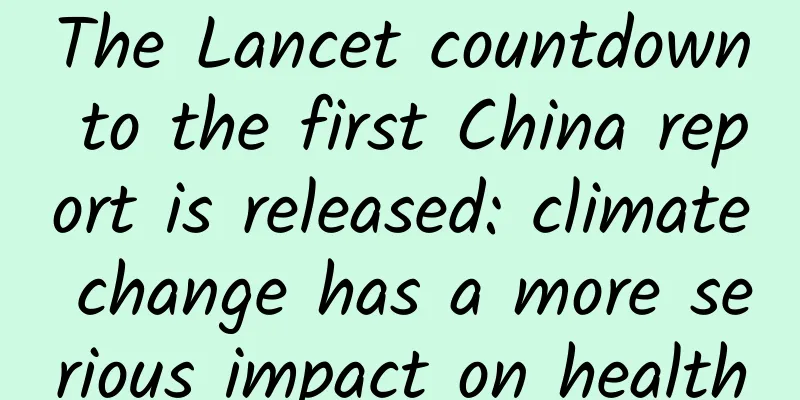The Lancet countdown to the first China report is released: climate change has a more serious impact on health

|
Recently, the 2020 annual report of The Lancet Countdown was released, which is also the fifth report since the establishment of the project. In 2015, countries around the world jointly adopted the Paris Agreement, aiming to curb the trend of global warming. The Lancet Countdown project came into being to examine the relationship between global climate change and human health. This year, the report launched the Lancet Countdown China Report, which was co-authored by Chinese scientists and is more in line with national conditions, for the first time, explaining the relationship between domestic climate change and human health. This article explains the areas in the two reports that are more relevant to people's lives. Although these topics have not received enough attention in China, research shows that we are facing multiple health threats. Written by | Xiaoye Original title: The first Lancet countdown report on China is released: Five years after the Paris Agreement, climate change has a more serious impact on health On December 2, 2020, The Lancet, an authoritative British medical journal, published online two heavyweight annual reports from the international cooperation project "Lancet Countdown": "2020 Lancet Countdown Health and Climate Change Report: Responding to the Convergence Crisis" (hereinafter referred to as the "Report") and "2020 Lancet Countdown Health and Climate Change China Report" (hereinafter referred to as the "China Report"). 2020 Lancet Countdown Report and China Report | Image source: [1] background As early as 2015, before the adoption of the Paris Agreement, the Lancet Commission published a research conclusion: addressing climate change is the most critical opportunity to improve global health in the 21st century. As a result, the Lancet Countdown: Tracking Progress on Health and Climate Change project came into being, bringing together more than 120 experts from 35 research institutes and UN agencies around the world to actively track the health of the global population and climate change data. Since 2016, The Lancet has published an annual report every year, clearly explaining how climate change has a negative impact on our health and the benefits of response measures. The report provides scientists with an important platform to speak out. Although this topic has been discussed abroad for many years, it is still little known in my country. This year, 77 researchers from 19 top research institutions at home and abroad, including Tsinghua University, University College London and the Chinese Center for Disease Control and Prevention, jointly wrote the first China Report based on the Report, which is in line with China's national conditions. The report analyzes five aspects, including the impact of climate change on the population, exposure and susceptibility; health and hygiene adjustments, planning and recovery strategies; climate change mitigation measures and health co-benefits; economic and financial support; and public and government participation, and summarizes 43 indicators to measure the relationship between health and climate change. However, although the world is taking action to mitigate climate change and has achieved certain results, the actual situation reflected by each indicator is not optimistic. For more than five years, the negative impact of climate change seems to have always been ahead of human action, and the outlook remains worrying. This article sorts out the content of the report and, combined with the China Report, extracts some information related to national life. High temperatures and heat waves are coming, and the mortality rate of the elderly is rising. In 2015, countries around the world jointly adopted the Paris Agreement, pledging to keep global warming below 2°C. However, data shows that 2015 to 2020 has become the six hottest years on record, with the global average temperature increasing by 1.2°C - our summer is getting longer and hotter. The report points out that exposure to high temperatures and heat waves, heat stress and heat stroke will aggravate the incidence of diseases such as cardiovascular disease, chronic respiratory disease and diabetes. The most affected groups are people over 65 years old, people with disabilities, people with a history of disease, outdoor workers, and people living in extreme conditions. According to statistics, from 2000 to 2018, the global heat-related mortality rate among the elderly population over 65 years old increased by 53.7%, and the number of deaths in 2018 was as high as 296,000, mainly in Japan, eastern China, northern India and central Europe. In 2019, the number of heat wave risk events exposed to the elderly over 65 years old increased by a record 475 million times, equivalent to an increase of 2.9 billion days, almost twice the previous record. The China Report points out that over the past 20 years, the number of days the national population has been exposed to the risk of high temperature heat waves has been steadily increasing. For the elderly population over 65 years old, it reached a record of 2.2 billion person-days in 2019. Compared with the early 2000s, each elderly person suffered an average of 13 more days of heat wave weather in a year. Among them, the region with the longest heat wave weather is Yunnan, followed by Hong Kong and Hainan. The number of heat wave-related deaths in China in 2019 was 26,800, and the growth trend was quite significant. Among them, the top three provinces with the highest mortality rates were Shandong Province, Henan Province and Anhui Province. The report analyzes that if this situation continues to develop, if the temperature rises by 2.0℃ each year in the future, from 2060 to 2099, the number of heat-related deaths in Chinese cities is expected to reach 27,900 each year. In addition to the number of people, the China Report also calculated the cost of heat-related deaths, which resulted in significant economic losses. In 2019, the economic losses caused by heat-related deaths reached US$13.6 billion, equivalent to the economic income of more than 1.3 million people in the country in the same year. In 2017, the absolute economic cost of labor losses caused by heat-related deaths was as high as US$126 billion (1.14% of China's GDP), equivalent to the country's fiscal expenditure on science and technology or environmental protection for a whole year. The three provinces with the most serious losses were Guangdong, Hainan and Guangxi. Changes in China's heat wave-related mortality rate from 1990 to 2019 | Source: China Report Frequent extreme weather events exacerbate the spread of infectious diseases. Everyone must have fresh memories of the Australian bushfires that burned from September 2019 to the beginning of 2020. According to a report released by the World Wildlife Fund (WWF), bushfires killed or displaced nearly three billion animals. Wildfires are one of the extreme weather events, and others include floods, droughts, hurricanes, etc. From last year's Australian fires to this year's California fires and Godzilla dust storms in the United States, they are all extreme events. There is growing evidence that climate change affects the frequency and intensity of such events. At the same time, extreme weather events have multiple negative impacts on human health, such as casualties caused by forest fires, acute and chronic respiratory syndrome caused by thick smoke; waterborne diseases caused by droughts or floods, increased infectious diseases (vector-borne), and even damage to health services, causing mental illness, etc. The number of natural disasters related to extreme weather has been increasing over a long period of time from 1990 to 2019. From 2000 to 2017, the number of people affected by extreme weather events increased significantly in countries where health care spending decreased or increased the least. In contrast, the number of people affected decreased in countries where health care spending increased the most, demonstrating the importance of strong public health systems in responding to extreme weather events. On January 28 this year, bushfires were still raging outside Canberra, Australia. Compared with human lights, the fires illuminated the sky for most of the night. Scientific data has shown that Australia's bushfires are related to climate change. 丨Source: NICK-D/WIKIMEDIA COMMONS (CC BY-SA 4.0) The China Report points out that at the provincial level, from 2016 to 2019, the annual average number of days of human exposure to forest fires increased in 24 of the 34 provinces, with the main growth areas occurring in the northern and northeastern provinces, including Heilongjiang Province, Jilin Province and Tianjin, indicating the need to strengthen forest fire monitoring. In addition, from 2000 to 2019, the number of severe typhoon events in China showed a significant growth trend, especially in China's eastern coastal areas, which are extremely vulnerable to tropical typhoons, resulting in casualties. But the good news is that as the government has taken active adjustment and intervention measures, the degree of damage caused by tropical cyclones has been greatly reduced in hotspot provinces including Fujian and Zhejiang during the same period. The COVID-19 pandemic that has raged around the world this year has made people see the hideous face of infectious diseases, but there are far more viruses than just the new coronavirus. Changing climate conditions are increasingly conducive to the widespread spread of infectious pathogenic viruses. In the study of the effect of climate suitability on disease transmission, the report tracked the three major infectious diseases that threaten the world: dengue fever, malaria (Plasmodium falciparum) and pathogenic Vibrio bacteria infections. The researchers established a mathematical model and drew some conclusions based on data from the last century. Climate conditions in 2018 were particularly favorable for dengue transmission. From 1950 to 2018, global climate suitability for disease transmission by the Aedes aegypti mosquito increased by 8.9%, while climate suitability for Aedes albopictus increased by 15.0%. For malaria, a long-standing adversary, climate suitability for highland malaria transmission increased by 38.7% in Africa and 149.7% in the Western Pacific from 2015 to 2019. Finally, in coastal areas where pathogenic Vibrio infections are widespread, climate suitability increased by 50.6% between 40 and 70 degrees north latitude over the past five years. Contrary to what one might imagine, these infectious diseases have not disappeared in China. From 2014 to 2018, the climate suitability for the two Aedes mosquito species to spread dengue virus also increased. In addition, in 2017, the incidence of dengue fever in all age groups nationwide increased by 5.7 times. At the same time, other climate-sensitive infectious diseases will also bring further infection risks to people. Take malaria as an example. In southern China, if the air temperature increases by 1-2°C, the transmission potential of malaria will increase by 39%-140%. Insufficient national action may lead to medical systems being overwhelmed. New data in the report show that despite improvements in medical care, our ability to respond to future health crises is still insufficient. Of the 101 countries surveyed, 50% have developed national health and climate change action strategies, but financial support is the main obstacle to taking concrete actions, with only four countries reporting sufficient national funding. In addition, less than half of the countries have assessed health susceptibility and adaptability. Of the 814 cities surveyed worldwide, climate change is expected to have a serious impact on public health infrastructure in two-thirds of them. This year's COVID-19 pandemic has posed severe challenges to the health systems of various countries. It can be said that it has completely changed the medical demand pattern, and many countries have had to reorganize their health system services overnight. However, the epidemic is still spreading, and the health risks caused by climate change are still "looking at us". We cannot fully understand the impact of these changes at present, but the report calls for concrete measures to mobilize all sectors of society and adjust and strengthen national and local public health systems and basic measures to prevent problems before they occur. China has actively responded to the current challenges. In 2007, my country promulgated the "China National Plan for Addressing Climate Change", which began to explicitly mention the impact of weather changes on human health. At the provincial and municipal levels, local governments are also gradually developing action strategies for mitigating climate change to protect human health. However, the "China Report" also pointed out shortcomings. According to the evaluation indicators, China's current action strategies are still at the initial stage. In view of the different geographical characteristics and socioeconomic conditions of various regions in China, more local specialized evaluation and management strategies are needed to ensure that the medical system can respond to possible public health risks. China has exceeded its carbon emissions target. During the energy transition, the concentration of greenhouse gases in the global atmosphere directly affects the global average temperature. Since the Industrial Revolution, the concentration of greenhouse gases has continued to rise, and so has the global average temperature. The most abundant greenhouse gas in the atmosphere is carbon dioxide, which mainly comes from the burning of fossil fuels. Therefore, in order to achieve the goals of the Paris Agreement, reducing carbon dioxide emissions is an important task to mitigate climate warming. The report shows that since 2010, global greenhouse gas emissions have increased by an average of 1.4% per year. In 2018, greenhouse gas emissions reached 51.8 billion tons of carbon dioxide equivalent (GtCO2e), a record high, of which the combined emissions of electricity, transportation and industrial production were 37.5GtCO2e, mainly from low- and middle-income countries. Shockingly, the emissions of the richest 1% of the world's population are more than twice those of the poorest 50%. The rich group needs to reduce its carbon footprint by at least 30 times to be consistent with the goals of the Paris Agreement. However, the COVID-19 pandemic has "helped" reduce carbon dioxide emissions. According to statistics, global emissions decreased by 8% in 2020 due to the suspension of economic activities and strict domestic and international travel restrictions. However, this is only a short-term effect caused by the temporary compulsory measures taken to deal with the epidemic. The report states that as countries gradually resume economic revitalization activities, governments should continue to take necessary intervention measures to mitigate climate change in order to achieve long-term effects of reducing emissions and protecting public health. Thermal power generation remains the main source of greenhouse gas emissions in the energy sector, and is also the main cause of air pollution and premature death. From 2017 to 2018, global coal energy use increased by 1.2%, and China was the main factor driving the growth, accounting for 52% of the global coal energy consumption. However, China's global share of coal power generation is declining rapidly, from 80% in 2007 to 66% in 2018. Agricultural production and the food industry contribute 20%-30% of global greenhouse gas emissions, with meat and dairy livestock industries contributing particularly large amounts of emissions, accounting for 56% of total agricultural emissions. The report studied deaths caused by excessive consumption of red meat and found that in the past 30 years, the mortality rate caused by excessive consumption of red meat has increased by 70%, and now most of the approximately 990,000 deaths each year occur in the Western Pacific and Europe and the United States. China's economy has developed rapidly in recent decades, and its carbon emissions have gone through different stages. Since 2000, carbon dioxide emissions have increased at an average annual rate of 10%, reaching a peak in 2013. As air pollution control measures were implemented, they decreased year by year from 2014 to 2016, and then rebounded to 11.6GtCO2e in 2017. By 2019, China's carbon dioxide emissions per unit of GDP in 2019 had dropped by 48% compared with 2005, exceeding the target originally scheduled for 2020. The detailed data analysis of the China Report also proves that China's total coal energy supply has been declining from 2013 to 2016, and the Chinese government's investment in new coal-fired power plants has also been gradually declining since 2015. This is exactly the focus of the Chinese government's current emission reduction direction: adjusting the energy structure and reducing the use of fossil energy. On September 22 this year, China proposed the goal of "peaking carbon emissions by 2030 and achieving carbon neutrality by 2060" at the 75th United Nations General Assembly. China's Fujian offshore wind power million-kilowatt wind farm | Image source: Internet At the same time, clean renewable energy continues to develop and is expected to become an effective way to replace fossil fuels. According to statistics, from 2015 to 2017, global low-carbon energy power generation increased from 10% to 33% of total power generation, and China was the main contributor. From 2010 to 2017, China's wind and solar power generation grew at an average annual rate of 38%, exceeding the global growth rate of 21%. At the same time, in 2019 alone, China's newly installed solar and wind power plants generated 26.8 GW (solar) and 25.7 GW (wind) respectively. However, China's share of renewable energy power generation is relatively small, only 6.5%, and there is still room for development. Efforts are still needed to control environmental PM2.5 pollution. Air pollution is the most important global environmental risk factor for premature death, and the situation varies from country to country. In Europe and China, from 2015 to 2018, due to the adoption of a large number of technical means to strictly control emissions and reduce the use of coal raw materials, the related mortality rate showed a downward trend. Although the number of premature deaths caused by PM2.5 produced by coal combustion was 390,000, a decrease from 440,000 in 2015, the number of deaths caused by global environmental PM2.5 pollution increased from 2.95 million to 3.01 million in 2018. Air pollution has a more serious impact on countries with lower socioeconomic levels. 91% of people who died from environmental pollution occurred in low-income and middle-income countries. In recent years, China has taken a number of actions to control air pollution, especially PM2.5. The China Report points out that the clean air policies adopted by the Chinese government, such as the Air Pollution Prevention and Control Action Plan, have reduced air pollution levels in 367 cities in China by nearly 28% from 2015 to 2019, reducing the number of deaths related to air pollution in my country by about 90,000 cases per year. However, in 2018, about 42% of the population in China was still exposed to air pollution, and the annual average concentration of PM2.5 exceeded the first transitional target set by the World Health Organization (the annual average concentration of PM2.5 was 35 μg/m³, the second target was 25μg/m³, the third target was 15μg/m³, and the air quality guideline value was 10μg/m³). In 2018, industrial and agricultural emissions caused 53% of environmental premature mortality, and at the regional level, the eastern part of China, where the industrial and agricultural levels are relatively developed, had the highest number of premature deaths. Except for some cities in Tibet, the PM2.5 concentration in all other cities in China still exceeded the annual average standard of 10 μg/m3 set by the World Health Organization. Therefore, the China Report recommends that the economic recovery measures and air pollution policies implemented by the Chinese government after the epidemic should continue to reduce the risk of population exposure to air pollution. From 2015 to 2018, the number of premature deaths related to PM2.5 exposure caused by different pollution sources in various regions of China | Source: China Report Mitigating climate change requires the joint participation of the media, academia, the public and the government. Mitigating climate change and protecting people's health is not just a slogan, but requires the full participation and collaboration of the general public, the scientific community, the government and enterprises. After conducting research and analysis on these aspects, the report summarizes two major trends: First, engagement with health and climate change continues to grow. From 2007 to 2019, media coverage of related content increased by 50%, while the output of related research content in scientific journals increased by more than 500%. From a personal perspective, researchers found that users' searches for articles related to both health and climate change are on the rise, based on keyword searches on Wikipedia. However, we can still see wealth inequality and political influence under such momentum. At the United Nations General Assembly, most of the countries that actively participated in discussions on health and climate change issues were those that did not promote climate change but were deeply affected by climate change, while the countries that led the scientific research on health and climate change were those high-income, high-emission countries that were also the main contributors to climate change. Second, attention to climate change still rarely involves its impact on health. Less than one-sixth of media reports on climate change discuss the issue from a health perspective, and less than one-tenth of scientific research articles on the topic. In the political sphere, government leaders rarely make a close connection between health and climate change in their speeches at important UN forums. The China Report clearly points out China's obvious shortcomings in terms of participation. Whether it is the media, individuals or academia, the response to the issue of health and climate change has always been mediocre. For example, in 2019, only 67 relevant articles were found in the five major media surveyed in the report. On Baidu, the main domestic search platform, few individuals will search for related content by linking public health and climate change. As for the scientific research community, a total of 15 Chinese and 30 English scientific research articles were published on related topics in 2019. However, compared with 12 Chinese articles and 3 English articles in 2008, this shows that the domestic scientific community is gradually paying attention to this issue, and it is expected to continue to deepen in the future. In summary, both reports convey an important message: no country, rich or poor, is immune to the negative health effects of climate change. The Lancet's editorial on the report emphasized: "The two crises of climate change and the new crown epidemic are both caused by environmental degradation caused by human activities. The occurrence of both is not entirely unexpected, and slow, ineffective or even wrong actions have led to many avoidable deaths. As countries around the world are busy with post-epidemic economic recovery, decisions must take into account and address these two crises at the same time to ensure that the most effective response to each crisis is taken." Climate change may not affect our lives yet, but when the crisis strikes, none of us will be immune. References 1.https://www.lancetcountdown.org/2020-report/ 2.https://www.thelancet.com/journals/lancet/article/PIIS0140-6736(20)32290-X/fulltext 3.https://www.thelancet.com/journals/lancet/article/PIIS0140-6736(20)32579-4/fulltext 4.https://www.thelancet.com/journals/lanpub/article/PIIS2468-2667(20)30256-5/fulltext 5.http://news.sciencenet.cn/htmlnews/2020/12/449546.shtm 6. https://zhuanlan.zhihu.com/p/334380292 |
<<: Is the stent implant a permanent solution? Here are some facts about heart stent implants
>>: What are the benefits of eating wax gourd? What soup is good with wax gourd?
Recommend
What causes bleeding during 28 weeks of pregnancy?
When a woman becomes pregnant, she must hope that...
What to do if you have excessive menstrual bleeding? Traditional Chinese medicine has a way to treat it
Menstruation is something that women experience e...
Will I still have my period during the month of pregnancy?
Will I still have my period this month during pre...
What to do if there is inflammation after curettage? Active prevention is the key
There are many inflammations that may be caused a...
Female discharge has a fishy smell
The genitals of a normal woman should have no odo...
What is the best medicine for women's body odor?
Through investigation, it was found that women ar...
What disease will a woman get if she is often angry?
Being angry is not a good thing. It is not uncomm...
Post-holiday syndrome! Feeling sleepy at work after the holiday, is it just because of lack of sleep?
China Science and Technology News Network, Januar...
What is the mortality rate of malignant hydatidiform mole?
In fact, the occurrence of hydatidiform mole is d...
Standard weight for girls 1.6 meters tall
Nowadays, most women consider thinness as beauty,...
Why do nipples become inverted?
Inverted nipple is a phenomenon that many women h...
What are the dangers of the "cold on the outside, hot on the inside" school of psychoanalysis that require sufficient attention?
In recent years, more and more people have discov...
Treatment of postpartum breast pain
Breast pain in postpartum women may be caused by ...
What is the reason for the enlargement of uterine fibroids in the abdomen after moxibustion?
Uterine fibroids are a common benign tumor among ...
What to do if your breasts hurt because your bra is too tight?
For adolescent or adult women, wearing a bra is a...









